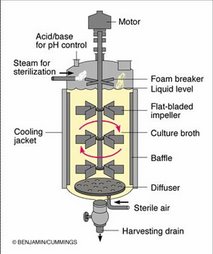A. BATCH PROCESSING OR CULTURE
At about the onset of the stationary phase, the culture is disbanded for the recovery of its biomass (cells, organism) or the compounds that accumulated in the medium (alcohol, amino acids), and a new batch is set up. This is batch processing or batch culture.
The best advantage of batch processing is the optimum levels of product recovery. The disadvantages are the wastage of unused nutrients, the peaked input of labour and the time lost between batches.
B. CONTINUOUS PROCESSING OR CULTURE
The culture medium may be designed such that growth is limited by the availability of one or two components of the medium. When the initial quantity of this component is exhausted, growth ceases and a steady state is reached, but growth is renewed by the addition of the limiting component. A certain amount of the whole culture medium (aliquot) can also be added periodically, at the time when steady state sets in. The addition of nutrients will increase the volume of the medium in the fermentation vessel. It is so arranged that the increased volume will drain off as an overflow, which is collected and used for recovery of products. At each step of addition of the medium, the medium becomes dilute both in terms of the concentration of the biomass and the products. New growth, stimulated by the added medium, will increase the biomass and the products, till another steady state sets in; and another aliquot of medium will reverse the process.
This is continuous culture or processing. Since the growth of the organism is controlled by the availability of growth limiting chemical component of the medium, this system is called a chemostat. The rate at which aliquots are added is the dilution rate that is in effect the factor that dictates the rate of growth.
The events in a continuous culture are:
a) the growth rate of cells will be less than the dilution rate and they will be washed out of the vessel at a rate greater than they are being produced, resulting in a decrease of biomass concentration both within the vessel and in the overflow;
b) the substrate concentration in the vessel will rise because fewer cells are left in the vessel to consume it;
c) the increased substrate concentration in the vessel will result in the cells growing at a rate greater than the dilution rate and biomass concentration will increase; and
d) the steady state will be re-established.
Hence, a chemostat is a nutrient limited self-balancing culture system, which may be maintained in a steady state over a wide range of sub-maximum specific growth rates.
The continuous processing offers the most control over the growth of cells.
Commercial adaptation of continuous processing is confined to biomass production, and to a limited extent to the production of potable and industrial alcohol.
The steady state of continuous processing is advantageous as the system is far easier to control. During batch processing, heat output, acid or alkali production, and oxygen consumption will range from very low rates at the start to very high rates during the late exponential phase. The control of the environmental factors of the system becomes difficult. In the continuous processing, the rates of consumption of nutrients and those of the output chemicals are maintainable at optimal levels. Besides, the labour demand is also more uniform.
Continuous processing may suffer from contamination, both from within and outside. The fermenter design, along with strict operational control, should actually take care of this problem.
The production of growth associated products like ethanol is more efficient in continuous processing, particularly for industrial use.
Continuous culturing is highly selective and favours the propagation of the best-adapted organism in culture.
A commercial organism is highly mutated such that it will produce very high amounts of the desired product. But physiologically such strains are inefficient and give way in culture to inferior producers--a kind of contamination from within.
C. FED-BATCH CULTURE OR PROCESSING
In the fed-batch system, a fresh aliquot of the medium is continuously or periodically added, without the removal of the culture fluid. The fermenter is designed to accommodate the increasing volumes. The system is always at a quasi-steady state.
Fed-batch achieved some appreciable degree of process and product control.
A low but constantly replenished medium has the following advantages:
a) maintaining conditions in the culture within the aeration capacity of the fermenter;
b) removing the repressive effects of medium components such as rapidly used carbon and nitrogen sources and phosphate;
c) avoiding the toxic effects of a medium component; and
d) providing limiting level of a required nutrient for an auxotrophic strain.
Production of baker's yeast is mostly by fed-batch culture, where biomass is the desired product. Diluting the culture with a batch of fresh medium prevents the production of ethanol, at the expense of biomass; the moment traces of ethanol were detected in the exhaust gas.
The production of penicillin, a secondary metabolite, is also by fed-batch method. Penicillin process has two stages: an initial growth phase followed by the production phase called the 'idiophase'. The culture is maintained at low levels of biomass and phenyl acetic acid, the precursor of penicillin, is fed into the fermenter continuously, but at a low rate, as the precursor is toxic to the organism at higher concentrations.










